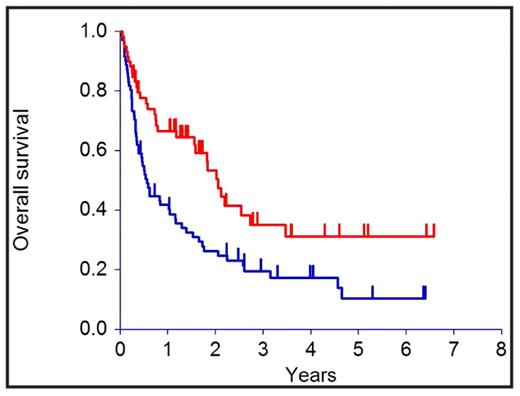Abstract
Whether the CD34+ cell dose affects the outcome of allogeneic blood cell transplantation is contentious: it is generally accepted that low doses increase transplant-related mortality (TRM) but it is unknown if very high doses compromise outcome by increasing GVHD. The aim of this analysis was to see if an optimum CD34+ cell dose (106/kg ideal body weight) could be found among 130 patients undergoing reduced-intensity allografts after 100 mg/m2 melphalan (+ 50 mg/kg cyclophosphamide if no prior autograft). GVHD prophylaxis comprised cyclosporine/tacrolimus and MMF.
Among patients receiving CD34+ cell doses of <3 (n=8), 3–3.99 (n=9), 4–4.99 (n=17), 5–5.99 (n=31), 6–6.99 (n=29), 7–8 (n=30), and >8 (n=6), the overall survival (OS) of the last group was the worst. Using the likelihood-ratio statistic for proportional-hazards regression models, the outcome of the first 4 groups was found to be not significantly different (P>0.05) from the last whereas those receiving 6–6.99 (RR 0.23; P=0.003) and 7–8 (RR 0.25; P=0.004) fared better.
Amongst the 124 patients receiving ≤8/kg, an increasing cell dose was associated with improving OS when analyzed as a continuous variable (RR 0.8759; 95% CI: 0.7695–0.9970; P=0.045), and the OS of those receiving 6–8/kg was better than those getting <6/kg (RR 0.55; 95% CI: 0.35–0.85; P=0.008). When all 130 patients were analyzed, the OS of patients getting 6–8/kg (n=59) was significantly better than the rest (n=71) (RR 0.52; 95% CI: 0.33–0.80; P=0.003).
When the CD34+ cell dose was entered into a Cox model (6–8 vs the rest) with the 6 other variables found to be independently significant in this population of patients (performance status 2–3, HLA mismatch, refractory disease, donor age >45 y, high LDH, and platelets <100), the 6–8/kg cell dose was found to be associated with better OS (RR 0.60; P=0.027) and all other variables retained their significance. Similarly, if 3 categories of CD34+ cell doses were entered into the Cox model (<6 vs 6–8 vs >8), 6–8 was better (RR 0.33 vs >8; P=0.029, and RR 0.63 vs <6; P=0.047).
The 6–8 cell dose was associated with lower relapse (RR 0.72; P=0.19) and TRM (RR 0.61; P=0.19) when analyzed with other variables significantly affecting these outcomes; suggesting that its beneficial effect on OS may be a combination of improved relapse and TRM. There was no significant correlation between the cell dose and some donor characteristics (sibling/unrelated, gender, and HLA match). Donor age ≤45 was associated with a cell dose of 6–8 (55% vs 34% for >45 y; P=0.02). We conclude that the CD34+ cell dose affects outcome of reduced-intensity allogeneic HSCT. This finding is important because this is the only potentially modifiable factor that can be manipulated in practice. Based on our data and pending more studies, we recommend 6–8 x 106 per kg ideal body weight to optimize outcome.
Disclosures: No relevant conflicts of interest to declare.
Author notes
Corresponding author


This feature is available to Subscribers Only
Sign In or Create an Account Close Modal